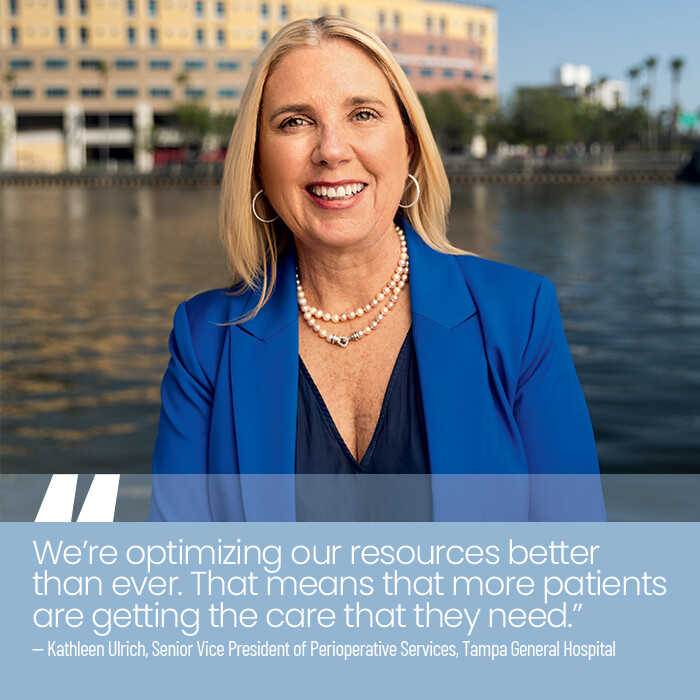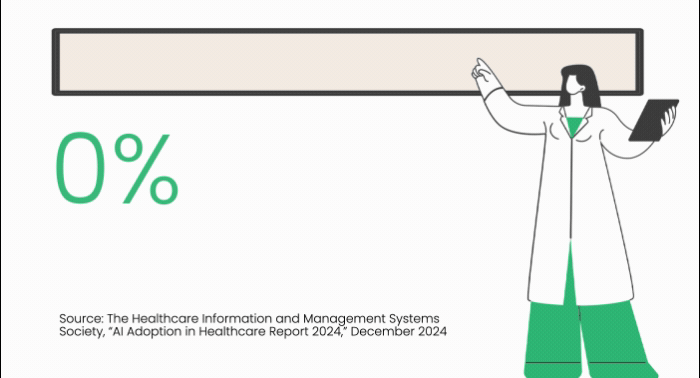How AI Is Supporting Hospitals’ Operating Rooms

Hospitals know too well that surgical delays aren’t good for patient outcomes. They can also negatively impact patient satisfaction and drive up treatment costs.
“Imagine getting a life-changing diagnosis, and you need to get into the operating room,” says Kathleen Ulrich, senior vice president of perioperative services at Florida-based Tampa General Hospital. “The last thing you want to hear is that you’re going to have to wait because there’s no room on the surgical schedule.”
Hoping to minimize such delays, Tampa General announced the launch of a new surgical operations system in 28 of its 52 operating rooms (ORs) in summer 2024. The platform leverages cameras and artificial intelligence (AI) to provide real-time insights that surgical teams can use to accurately predict schedule-pertinent metrics such as case durations and turnover times.
The only similar information the hospital had to work with previously was data derived from manually entered time stamps from electronic health records. That approach, Ulrich explains, was time-consuming and prone to human error. This new technology is entirely automated and captures everything, “wheels in to wheels out to wheels in again,” she says.
Click the banner below to read the new CDW Artificial Intelligence Research Report.
Now, before scheduling a procedure, administrative staffers know how long it should take based on the system’s calculations, which are specific to the case history of the assigned surgeon. This information is used to customize the daily schedule, with minor adjustments made on the fly in response to live feeds from in-room cameras.
“They can see what’s happening inside 24/7,” Ulrich says. “Now, they don’t have to call into the room to ask the surgeon where they are in the case. They know when that procedure is about to wrap up and when they should be ready for the next one.”
This new process is helping Tampa General save more than 3,000 minutes per week in time previously lost to surgical inefficiencies, she adds. In the hospital’s first year with the tool, it has the potential to schedule more than 600 procedures that it otherwise could not have offered.
“We’re optimizing our resources better than ever,” Ulrich says, “and that means that more patients are getting the care that they need.”
Accelerating Adoption of AI to Streamline OR WorkflowsIn one study, 1 in 9 Americans said they had at least one surgical procedure the previous year. Such numbers make clear why Tampa General needs solutions to help streamline its OR operations.
A 2024 Philips report found that 84% of U.S. healthcare leaders believe that automation will save their workers time by reducing daily administrative tasks, and 76% believe that automation will allow their care teams to perform at their highest skill levels.
“Hospital operating rooms are focused on three very important areas,” says Dr. Teodor Grantcharov, professor of surgery at Stanford University and associate chief quality officer for innovation and safety at Stanford Health Care.
One top concern is efficiency, not only to provide services to all who need it but also to maximize hospital revenue. Another is compliance with standard safety procedures to minimize the risk of harm to patients. Then, there’s the related drive to improve care quality, to push for outstanding surgical performance through case analyses and clinician education.
AI is now being used for each of these purposes and more, Grantcharov says. He is also a practicing surgeon and the inventor of an AI-powered solution called the OR Black Box, which is designed to holistically tackle perioperative quality, safety and efficiency.
It won’t be long before every OR in the U.S. will rely on some kind of AI-enhanced technology, he notes: “Adoption is accelerating so quickly that it’s really just a matter of time.”

In Northern California, MarinHealth is already well-versed in the benefits of AI in the OR. At the 327-bed MarinHealth Medical Center, vascular surgeon Dr. Allan Conway has been using an AI-based anatomy-mapping technology to assist him with aortic aneurysm repair.
The platform takes data from a patient’s preoperative CT scans and deploys AI to develop 3D images of affected blood vessels. The system also provides analyses of any physiological or anatomical changes that could prove critical to clinical decision-making.
“It gives us real-time guidance as to where the aneurysm is, so we know exactly how to place the stent,” Conway says. “It’s really impressive, completely accurate. It’s changed how we do these procedures.”
For instance, his team now takes fewer X-rays, and they’ve reduced the volume of X-ray dye they inject into patients’ blood vessels for imaging purposes.
“It’s made these procedures safer for patients and staff, and it’s reduced time spent in the OR,” Conway says. “We’re happy, and the patients are happy because they’re getting better outcomes, and the administrators are happy because we’re more efficient.”
RELATED: How can AI help transform radiology?
Time to Automate Surgery SchedulingImproving patient outcomes is also a top priority for Phoenix, Ariz.-based Banner Health, which operates nearly three dozen hospitals in six states and is among the largest nonprofit health systems in the U.S.
The organization first looked to AI as a way to optimize OR scheduling and operations, says Dr. Nirav Patel, medical director of surgical and procedural services. A key measure of success would be the impact the technology had on patients.
“We wanted to improve access and the ability of patients and doctors to use the resources we have available,” Patel says. “If we could improve how surgeons booked their cases, they would be better able to care for their patients.”
With that in mind, Patel and his colleagues turned their attention to surgical “block times,” or the consecutive hours on any given day that Banner Health reserves ORs for single surgeons.
“The challenge is, you get this block of time, but then there’s variability depending on your service line and factors like how busy you are,” he says. Certain surgeons also cancel their block times more than others, and some tend to do so with minimal notice.

Muddling things further, Banner Health depended on manual processes for scheduling surgical services. At a hospital with just a few ORs, that might not be a problem, but Banner Health has nearly 350 ORs across its many academic and community facilities.
“It was a lot to manage with emails, calls and faxes. There was a lot of back-and-forth involved,” Patel says.
That was all before late 2023, when the health system began phasing in an operations automation solution that uses AI and machine learning to analyze surgical data and behavioral trends. It then provides the surgical and procedural services team with up-to-the-minute scheduling predictions.
“I compare it to OpenTable,” Patel says. “If I want a reservation at a restaurant, I can see what’s available and I can book it. It’s the same concept here with OR availability. When an operating room is going to be open, the system gives you a way to plan for that.”
As is the case at many hospitals, some of the surgeons at Banner Health are directly employed by the organization, while others are independent providers with contracts that allow them to use its facilities as needed. That combination can be good for patients and business overall, but it can also make scheduling complicated.

Tampa General Hospital is using artificial intelligence in many of its operating rooms to transform surgical processes to improve efficiency and reduce care delays.
The new tool simplifies the process by learning individual surgeons’ patterns, such as when they typically operate and how long they usually take to finish their work.
“Now, we can look at each surgeon and say, ‘If we have eight hours of OR time available, what’s the chance that Dr. X is going to use all of that time?’” Patel says. The answer is then used to build the schedule, an approach he describes as “extremely successful.”
Banner Health is now exploring how it might use AI to improve care quality and patient safety, which could include adopting a video solution similar to that used in Tampa General’s ORs.
“We’re always looking for new opportunities,” Patel says. “It’s a technology that’s going to allow us to serve our customers better.”
UP NEXT: How can healthcare organizations overcome AI implementation hurdles?
healthtechmagazine





